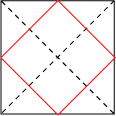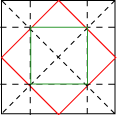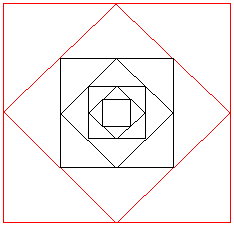Copyright © University of Cambridge. All rights reserved.
'Inside Seven Squares' printed from https://nrich.maths.org/
Show menu
Why do this problem?
This problem provides a challenge when you are focusing on drawing lines and shapes accurately, or finding areas either by counting squares or calculation. The problem calls on learners' understanding of squares and right-angled triangles, and requires working systematically, as well as visualisation and reasonably accurate drawing.Possible approach
You could introduce this problem by making the beginnings of the design using paper folding. Each learner will need a square of paper. (This could be made in class by folding the end of the sheet diagonally, thus forming a square and cutting off the excess.)
Take the square of paper and fold it both ways diagonally so finding the centre. Fold each corner to the centre and crease it. Thus forming the second square (in red).

After this, fold each side to the centre and crease, forming the third square (in green).

Learners could be challenged to continue this process which becomes increasingly difficult and prone to inaccuracy. This introduction will show learners where the problem "is coming from".
Provide $1$ cm$^2$ paper, or even better, square dotty paper, sharp pencils and rulers for working on the actual problem. Learners would benefit from working in pairs so that they are able to talk through their ideas with a partner but should do their own drawing. This sheet, showing the diagram, could prove useful.
Learners could be left on their own to discover the best place to start the drawing and the best size to choose, or the whole group could discuss this together before they begin working individually.
At the end of the lesson learners can discuss both their methods for tackling the drawing and for finding the area of the four triangles. There are several different ways of answering the problem and it can be done without any drawing at all, so there should be plenty to talk about. It might be useful, if no one has suggested it, to cut out the four triangles and put them together as a
square.
Key questions
What would be a good way to start, with the first, smallest square or the largest one?
How big should you draw the centre square to make it easier to draw the others?
Is that a $45^o$ angle?
Now you have done the drawing, how are you going to find the area of the four triangles?
